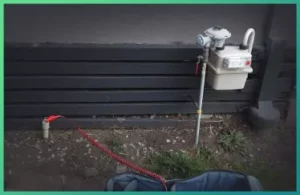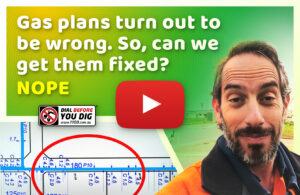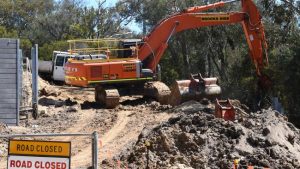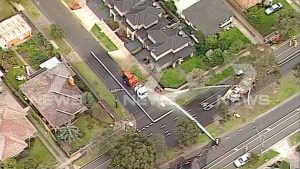Last week there was another gas leak – this time it was in Bathurst CBD, after the council hit and damaged an underground gas pipe. Here’s a link to the story in the Western Advocate if you’re interested in reading their article.
Every day, somewhere around the country, there are gas pipes being hit and damaged. Here are a handful of ones that got reported in the media and that we shared on our Facebook page in 2015. (We’ve left off the other ones that we share on our Linkedin page because the list is long enough already!)
- Gas pipe hit and damaged causing evacuation of Flemington Primary School
- Gas leak in Port Douglas caused by council worker
- 1 man dead and 2 others injured after excavator hits gas pipe in America
- Gas pipe hit in an outer Geelong suburb. Why didn’t they just call us before they dug? We’re 6 minutes away from there 🙁
- Excavator hits gas pipe in East Brighton
- Dingo goes through a gas pipe
- Busy Collins Street, Melbourne comes to a standstill because someone hit the gas pipe
- 660 students evacuated from university, when a gas pipe is hit and damaged
- Circus coming to town, maybe someone better tell them where the gas pipes are so they don’t damage them, like these guys did
- Building evacuated after gas pipe was damaged
- 250 students evacuated from another school when workers hit a gas pipe
- Homes and businesses evacuated after excavator digs up gas pipe
- Directional driller hits underground gas pipe
- Residents have to stay inside on Australia Day, because someone working in the area has hit and damaged a gas pipe
- Gas pipe hit in Wangaratta causing a gas leak
- Gas leak in Williamstown
And of course these are just some of the ones that get reported by the media. But as most of you know the majority of gas pipe damages actually go unreported.
So for a while I’ve been meaning to write a post about all the gas pipes being hit and ways you can avoid hitting them. I finally had time over the weekend, so here is the post below. I hope it can help you out on the next project you are working on.
As a locator I can tell you that gas pipes are one of the hardest utilities to locate
Plastic pipes with no trace wires; poor workmanship when they are installed; plans with the wrong details on them; even digging down to expose it and finding an abandoned main and confusing it with the live main that should be in the street. These are all very common reasons why gas pipes still continue to get damaged every single day across the country.

However, what I can tell you is that when you do hit one (and if you use machinery every day then the chances are you will), unless you can prove you’ve done everything possible to avoid damaging any underground services, you’ll be buried in meetings and paperwork as far as you can see.

You’ll then have to go through and explain every little aspect of the project and what led up to the gas pipe being damaged to your supervisor; then to his supervisors; WorkSafe; your OHS rep; your client; your client’s supervisor(s); their OHS rep; if you’re in the union then your union rep will come out as well (actually, even if you’re not they’ll still probably come out anyway); the fire brigade and the police will probably need to talk to you as well, if they’ve been called out.
And of course don’t forget every disgruntled resident who lives in the area. And every motorist who can’t take their normal route home will want to come over and have a chat to you.
And this assumes that the media hasn’t got a whiff of it. If they have, then you’ll have reporters asking questions and your PR reps coaching you as to what you can and can’t say.
As well as the meetings, every person you talk to will ask you to give you a report of what happened, so the paperwork will be ceiling high.
And this is all assuming that no-one got injured onsite.
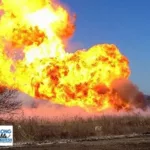
But we are talking about gas, so if it ignites and someone gets seriously hurt or worse, then you’ll be looking at years of going in and out of court trying to defend yourself. And it won’t only be you—your boss could also end up in court and possibly prison as well.
So what can you do?
My advice as a locator who spends every day trying to locate this stuff is simple: have a set, documented procedure that you can follow—and if need be, make it a checklist and tick it off on each project you’re on.
1 – Do a Dial Before You Dig request. You should know it already, but if not the website is www.1100.com.au
2 – Wait for all the plans to come back from the utility companies that have assets in the area before you start excavating.
3 – Read through both the plans and the paperwork that comes with them—they’ll talk about no-go zones, permits and conditions for working near their asset.
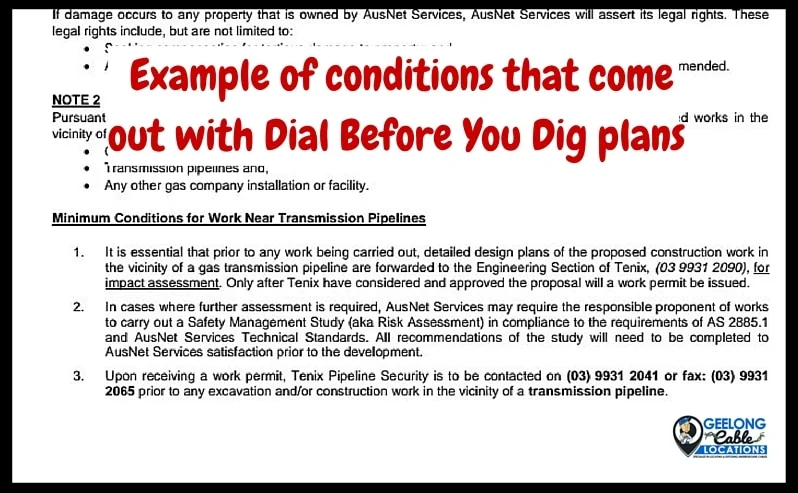
4 – If you think you’re trained up enough, have the experience, are willing to take on the responsibility and have the right accreditations, licences and/or permits, then locate the underground services in the area.
5 – If you don’t, then hire a professional locator to come out and locate them for you.
6 – If you’re hiring a locator, don’t just go for the cheapest option. When the shit hits the fan and they ask you why you chose that locator, saying he was the cheapest won’t look good on you. My advice is go to http://www.dbydlocator.com/certified-locators/ and pick someone from there. That way, if something goes wrong then at least you can say you picked a locator that Dial Before You Dig recommended.
7 – Once everything has been located, dig down and prove that it is definitely there and get an exact depth of it.
8 – Once you see it with your own eyes, go back to your plans and confirm that the pipe you see in the ground is the one that’s listed on the plan. If it’s not, then contact the utility company or your locator (if you’ve hired a professional locator in to locate it for you).
9 – Then, only after you have done all of the above, are you good to start getting into your works.
If you still have a hit and you’ve done all of this, well, firstly you are bloody unlucky. But, hey: it can happen. But this time, when everyone starts arriving and they are about to rip into you, hand them your check list and show them everything you’ve done to try and reduce the chance of you hitting something. At least if you can prove that you’ve done absolutely everything you can to reduce your risk of hitting an underground utility then, when it does start to go a bit pear-shaped, you will at least have a leg to stand on.
What I can tell you is that, unfortunately, even getting a professional locator out to site will still never completely eliminate the risk of you hitting an underground service. But what it will do is greatly reduce the risk of doing so.
If you are going to be doing any digging within Victoria and if you need a locator onsite, then you may want to keep reading on.
If you’re doing any digging in Victoria and need a locator, then feel free to give us a call on 1800 449 543 and we’ll be more than happy to help you out on your next project
At a minimum, I’d say at least once a day, one of us would come across a job in which we would locate an underground buried utility that the customer had no idea existed or that it was anywhere near where we have said it is.
But as we are talking about underground gas pipes in this post, let me very briefly share 3 separate examples, from jobs I’ve been to myself over the last 2 months, in which the customer has employed another locating company first and they’ve come out and marked everything that they could find on site. Then, when I get out to site, I have managed to find gas pipes that they had missed.
- The first job was at a hospital and it took a bit of investigating work because the signal kept jumping onto other services, but eventually, I was able to get it by following it backward from the end point in the basement car park to where they were digging in the garden bed.
- The second instance was in a prison and they initially had a guy out who only used ground penetrating radar. When I got there, I insisted on doing a full locate by hooking onto absolutely everything I could and locating it all out. Only then, at the end, I used the GPR and marked everything else out that I could find.
- The final case was in a residential street. Barely any of the gas services to the houses had trace wires on them. After spending half-a-day onsite with the locator marking everything conductive out (power cables, telephone cables, water pipes), I went back the following day and spent another 4 hours onsite using the GPR and found a heap of unknown services. We then went back a few days later with the NDD truck and potholed to see whether they were in fact underground services or whether they were just anomalies. To my surprise they were all services: some were old and abandoned gas pipes; some were old but still live; others were live and didn’t look like they had been in that long, but just weren’t listed on any of the gas plans.

Now, I don’t want this to sound like I am bragging, but it does feel good to know that even when customers get other locators in, they still know in the back of their minds that, if they have any concerns about what has been located, they can always rely on us to come out and double check over the whole site for them.
………….although, now that I think about it, it’s also kind of scary as well. Because I wonder how many locators there are out there that aren’t actually putting in 100% to try and find everything onsite. Or could it be that they just lack the required training or experience? Or could it even be that they simply don’t have all the necessary equipment to be able to do a full locate? Anyway, that’s for another discussion another day.
However…………I guess I have sort of already covered that topic in another post I did a few months ago about the Dial Before You Dig certification, and why you should only use a locator that has gone and sat the test and passed both the online exam and the full onsite assessment, which is independently assessed from Dial Before You Dig themselves. So maybe I’ll just leave that whole discussion off here and if you are interested in it then you can always read about what I wrote in the post by going to this link here.
So I’ll just wrap up this post by saying, as always if you have any questions at all about locating gas pipes or locating any underground utility, then feel free to get in touch with me.
If you feel you can contribute to this post, or even if you have a different view or a better 9-step process then feel free to leave a comment below.
In the meantime, I do hope you are well, take care and bye for now.
Regards
Ben

